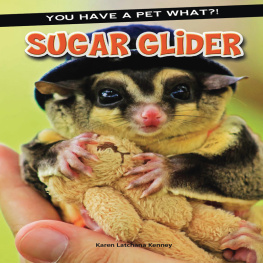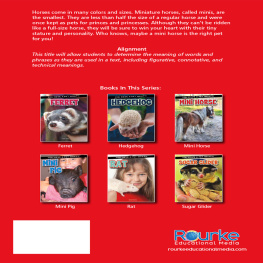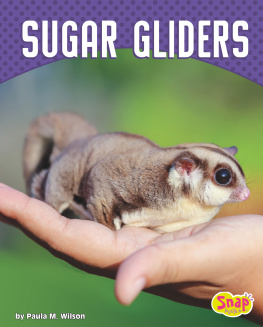Table of Contents
Guide

2016 Rourke Educational Media
All rights reserved. No part of this book may be reproduced or utilized in any form or by any means, electronic or mechanical including photocopying, recording, or by any information storage and retrieval system without permission in writing from the publisher.
www.rourkeeducationalmedia.com
PHOTO CREDITS: : GlobalP
Edited by: Keli Sipperley
Cover design and Interior design by: Rhea Magaro
Library of Congress PCN Data
Sugar Glider / Karen Latchana Kenney (You Have a Pet What?!) ISBN 978-1-63430-436-8 (hard cover) ISBN 978-1-63430-536-5 (soft cover) ISBN 978-1-63430-625-6 (e-Book) Library of Congress Control Number: 2015931859 Printed in the United States of America, North Mankato, Minnesota | Also Available as: 
|
Night Gliding
climbs out from its tree nest. It travels across a limb. Then it jumps!
The sugar glider spreads its four legs. Thin skin stretches from its wrists to its ankles. The skin acts like a kite. It catches the wind. The sugar glider soars from limb to limb. It searches for its next meal. Tree sap and insects are good finds.
A sugar glider is a , like a kangaroo. This is a kind of mammal. Only three kinds of mammals can glide. The sugar glider is one. Thats one reason this animal makes a unique pet.
FUN FACT
A sugar glider can glide up to 196 feet (60 meters). Thats about half the length of a football field!

is in Australia, Tasmania, Indonesia, and Papua New Guinea. These lands are in the Pacific and Indian Oceans. There, the sugar gliders live in forests. These forests usually have acacia trees.

Sugar gliders are social animals. They live in large groups ranging from 12 to 40 sugar gliders. One or two males lead the group. Females and children, called joeys, join the males. They usually make their nest inside a tree hollow. They line the hollow with leaves and shredded bark.

In the wild, sugar gliders live in trees. They rarely, if ever, touch the ground.
, which means they sleep during the day and are awake during the night.
At night they look for food. They eat both animals and plants.
Females have a pouch for their babies. After just 15 to 17 days, one or two joeys are born. The tiny animals crawl up to the pouch. There they feed and grow more. The joeys leave the pouch between 60 and 70 days later. Soon the mother takes each joey out of the nest. It clings to her back as she looks for food.
FUN FACT
Do you think sugar gliders like sweet foods? They sure do! Tree sap, fruit, and flower nectar are their favorites. They also eat insects and bird eggs.


A glider joey is born as tiny as a cooked grain of rice.
Sugar Gliders: Head to Toe
A sugar glider is a cute little creature. It reaches a length of 10 to 12 inches (25 to 30 centimeters). It weighs just three to five ounces (85 to 142 grams). Its soft fur is gray. A black stripe runs from its eyes to its tail. Its belly is a creamy white.

The sugar glider has many characteristics that help it survive in the wild.
Sharp Claws: Sharp, curved claws hook into trees as sugar gliders land. The front feet each have five claws. The hind feet have four claws each.
Thumbs: Each foot has a thumb. Sugar gliders use thumbs to grasp onto branches and limbs.
Sharp Teeth: Sugar gliders have between 40 and 46 teeth. Two large teeth are very sharp. They stick out and forward. Sugar gliders use them to chew tree bark.
Large Ears and Eyes: Their large ears can move in all directions. Sugar gliders can hear the quietest sounds. Large eyes stick out from the sugar gliders head. They help it see at night.
Patagium: This is the thin skin that sugar gliders use to glide. It stretches from the wrists to the ankles. When not gliding, the skin ripples at the animals sides.
Tail: A bushy tail helps sugar gliders balance on tree limbs. During a glide, the tail steers. It controls the direction of the glide.
Popular Pocket Pets
Sugar gliders love attention and people. Theyre pretty active, too. Watching them glide and play can be entertaining. An adult can fit in your palm or slip into your pocket. The sugar gliders big eyes and soft fur make it cute and cuddly. This is why people love having them as pets.

FUN FACT
In the wild, sugar gliders live from four to seven years. But as pets, these animals can live up to 15 years. Thats about the same lifespan as a cat or dog.
These cute animals are not right for everyone, though. Sugar gliders are not easy pets to care for.
First, they need a lot of attention. Can you take yours out to play every day? If not, can you can afford to care for two sugar gliders? Two sugar gliders can keep each other company.
Sugar gliders also need special food. Will you cut fresh fruit for them every day? Will you keep live insects in the house for them to eat? Knowing how to prepare their food is very important. They can get sick from fruits and vegetables that are not washed well.

Sugar gliders need a lot of space. Do you have room for a large cage in your home? There are many things to think about before choosing to own a sugar glider.

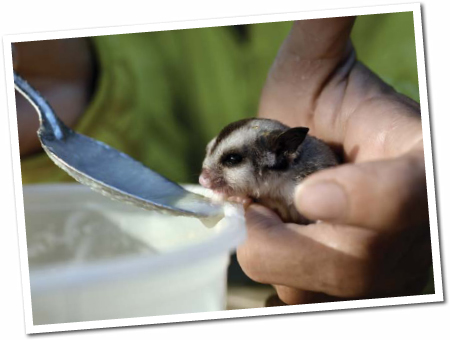
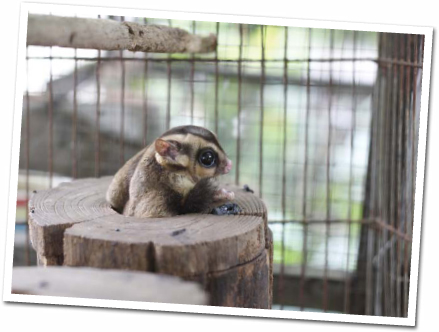
FUN FACT
Sugar gliders were first brought to the United States as pets in 1993.

